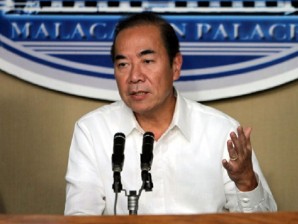MANILA, Philippines—Why don’t floodwater and asphalt mix?
The Department of Public Works and Highways (DPWH) has finally provided an explanation for the potholes that disfigured almost all roads in the metropolis after last week’s torrential rains and floods.
The official line of the agency tasked to repair and maintain the national road artery is that asphalt and water simply don’t mix.
“We noticed some potholes in those portions that were really submerged for a long period,” said DPWH Secretary Rogelio Singson in a Palace briefing on Monday.
“The enemy of asphalt is water. So if there is no efficient drainage—again, we go back to the flooding (problem)—that aggravates the quality of our roads. So when the roads are submerged in floodwaters, the asphalt (overlay) doesn’t last,” said Singson.
The DPWH has identified some “27,000 cubic meters of potholes,” possibly referring to the amount of asphalt needed to cover the potholes which are causing traffic gridlock and endangering motorists and pedestrians alike.
“As of this (Monday) morning, we already received a report that we have done about over 7,000 cubic meters. So we’re done with about a little over 24 percent. So weather permitting, we committed to finish in two weeks,” said Singson.
Despite doubts about durability of asphalt being used to overlay major roads, Malacañang nixed on Sunday an investigation into supposedly substandard asphalt materials being used by the DPWH for its periodic road maintenance work.
“DPWH is in charge of the repair and maintenance of national roads, while cities are in charge of municipal roads,” said deputy presidential spokesperson Abigail Valte, when interviewed Sunday by state-run Radyo ng Bayan.
Valte was mum on the liabilities of the private utilities and government agencies that have kept on digging up roads without returning them to the original state after the work.
Valte, however, pointed to the online campaign launched last Friday by Presidential Communications Development and Strategic Planning Office (PCDSPO), “#lubak2normal project.”
The drive seeks the assistance of Twitter subscribers to report the location of potholes, so that the DPWH could find and repair them.
“We welcome reports from citizens of potholes on national roads so we can forward to DPWH, which is why PCDSPO partnered with DPWH for the #lubak2normal project.
“In fact, for today alone, DPWH has sent out 45 teams to repair potholes all over Metro Manila,” said Valte.
The DPWH has already conducted technical assessment on the state of the road system especially in Metro Manila.
“And in fact, this morning we were just discussing … that in roads that are heavily used by loaded trucks, they bear the brunt of the destruction—San Marcelino, Romualdez, Nagtahan, Quirino (Avenues in Manila)—name it,” said Singson.
“So it looks like asphalt on those roads is not going to work. So we’re thinking or upgrading our specifications and use reinforced concrete on these segments,” said Singson.
He also mentioned the overflowing of the waterways caused by “clogged drainage because of solid waste,” he said, adding: “So definitely, the solid waste problem is aggravating the flooding situation.”
For 2012, the DPWH has a budget of P82.1 billion out of P104.9 billion for road construction and maintenance. The rest goes to flood control and “other projects.”
The agency constructs, repairs and maintains national arterial and secondary roads, and national bridges.
